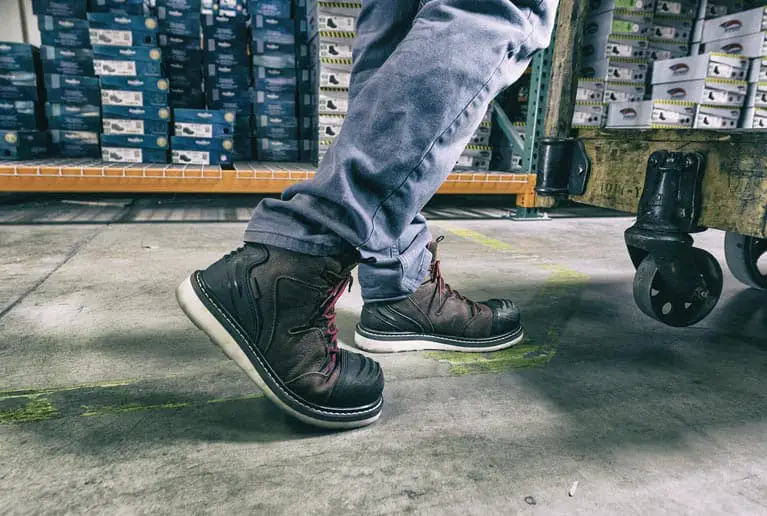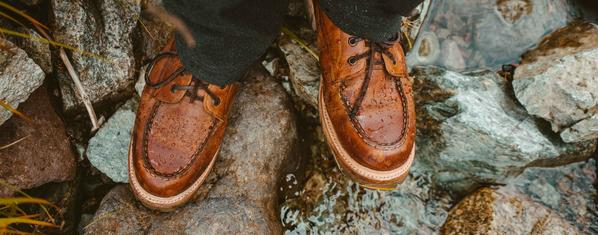
How often do we suffer from painful blisters caused by new work boots? How often do we avoid wearing them altogether to relieve ourselves from that pain?
I am certain that most of us have answered with ‘multiple times’ to the above questions. Work boots can indeed be a pain to break into, and we keep hoping for a shortcut to this problem. Unfortunately, there isn’t any, but to continue wearing them for as long as it takes to make them comfortable.
In case you’re wondering if work boots become more flexible over time – yes, they do but only to a certain degree. However, keep in mind that it takes a long time for them to reach the ideal point of flexibility, and this is true to only some type of work boots.
What are work boots made of?
Work boots are specifically designed to protect your feet from hazardous working environments, hence they are made of materials that are rigid and tough. Materials used are leather, rubber for a thick sole, and a steel toe cap.
Due to these materials work boots are not very flexible and take at least about 3 to 4 weeks to break into them; and for them to conform to the shape of your feet. However, there are some boots made of manmade or synthetic materials as well, which do not take so much time to expand.
How to Make Boots More Comfortable and Flexible
Since we are all aware of the fact that leather does not stretch out as we would want them to, there are certain hacks to make it easier on your feet before wearing them to your workplace.
1.) First and foremost; buy the right size of boots. Do not go for a size smaller or a size that does not have any room left for a pair of socks to fit in. Because it will be some of the most painful weeks of your life trying to break into them.
2.) Wear them in the house for a prolonged period. This will allow your boots to adjust to the shape of your feet gradually. There is no need to wear them the entire day, but just a couple of hours will suffice.
3.) You will be pleased to know that there is something called a leather conditioner. Apply some of it on your boots that will help in the expansion process as it moisturizes the leather, making it easier to bend its ways.
4.) Experiment by wearing them to work one day to see how much they’ve expanded already. If they fit well without any more pain, then take that victory and wear the boots all day. Longer the duration, the fit gets better, and the leather acknowledges the shape of your feet.
5.) The insoles can sometimes not be the best for your needs. In this case, you can buy additional insoles that will give an extra layer of cushion to your feet, which in turn makes it easier for you to be in them. Make sure that the insoles are of high-quality material like EVA material or memory foam.
6.) When you know that you will be needing a new pair of work boots, then it is advisable to buy them at least a couple of weeks earlier instead of buying it just a day before wearing them. This will give you ample time to maneuver all the methods necessary to expand them.
Along with knowing what to do to make the work boots fit you better, it is beneficial to also know what NOT to do.

1.) Do not immerse them in water as they will ruin the quality and longevity of your boots. Leather can only endure water to a certain magnitude.
2.) Do not apply heat directly on to the boots even if it gives you some level of comfort while wearing them. It will result in reducing the life span of the leather by minimizing its strength, durability, softness, and increasing noticeable cracks on them.
3.) Do not insert heavy objects inside the boots to expand the leather; as this will also minimize its sturdiness in the long run.
4.) Do not ignore any sort of pain, or pinching that occurs while putting them. Avoiding will only result in more pain, discomfort, and blisters.
Different Types of Boots available in the Market
There are various types of jobs or work that people do, it can either be a desk job or field job. A desk job does not require you to wear a certain type of footwear.
However, it is not the case with field jobs, as the latter demands a person to be out and about all through the day. Especially work that involves a person to be in a factory site, or industrial workplace, becomes prone to injuries.
Manufacturers and brands have managed to cater to the needs of such workers by designing specific work boots that can protect them from such injuries.
-
-
- Steel toe work boots – best for construction sites and factories with heavy machinery.
- Composite toe work boots – ideal for workplaces where they have metal detectors as it will prevent them from setting off.
- Electrical hazard work boots – perfect for workplaces that are vulnerable to electrical hazards.
- Oil-resistant work boots – for people dealing with oil and petroleum.
- Insulated work boots – good for protection in case of cold weather conditions and moisture.
- Waterproof work boots – preferred by individuals working in wet environments.
- Heat-resistant work boots – quintessential for mine workers.
- Slip-resistant work boots – beneficial for all kinds of workplace.
- Metatarsal guard work boots – advantageous for workers lifting or dealing with heavy objects.
- Puncture resistant work boots – valuable for people working in construction sites.
-
All of the above-mentioned work boots have their specific roles and functions to play in their area of work. Each of them has to be approved and certified by the American Society for Testing and Materials or in short ASTM. They set certain criteria and standards that manufacturers need to meet to make them safety work boots.
Wrapping up
Work boots are heavier than regular boots, and the reason for this is simple and self-explanatory. So expecting them to be flexible from the get-go is a bit of a far fetched dream for now.
Although there are flexible work boots in the market today, they will not guarantee the same amount of protection from extreme occupational hazards. They have less cushioning leading to reduced shock absorbency.
Understandably, comfort is equally necessary while working, especially in hazardous work environments, but safety is far more valuable to avoid any unforeseen injuries. Be smart to invest in a pair that is suitable for your work to avoid accidents of any kind.
Follow the simple recommended methods to make them flexible to meet your comfort level, and I assure you that it will be worth your time. So my advice would be to never compromise on the quality of your work boots!








